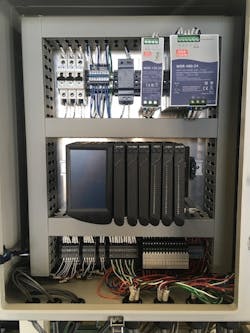Benson Hougland is vice president for Opto 22. Hougland can be reached at [email protected].
FCI Watermakers, based in West Valley, Utah, has been building freshwater systems since 1992. Most of these systems are skid-mounted and primarily convert salt water to fresh water via reverse osmosis. However, several other technologies also are used depending on the customer’s needs. The company found that ladder logic and an older PLC could not keep up with modern demands.
As an original equipment manufacturer, FCI designs the control systems for its products. When custom orders and larger systems became a larger part of its business, the company began looking for a more improved automation solution.
“Three or four years ago, ladder logic was the best fit for our HMI/PLC,” said Scott McGuire, president of FCI.
FCI found the PLC was limited to a finite amount of input/output (I/O) points, which was fine for smaller systems, but limiting for larger ones. To meet its needs, the company upgraded its control systems to Opto 22’s groov EPIC, which can be scaled for all FCI products and includes software for flowcharting, as well as IEC 61131-3-
compliant languages, such as ladder logic.
Making Freshwater
FCI started with two product lines in 1992, and has expanded to offer a range of systems, from those used on small yachts to systems for offshore oil platforms and resort hotels. These freshwater systems can produce from 200 gal per day (gpd) to up to 260,000 gpd. The products are typically built for marine environments, and also are ship-certified and marine grade.
FCI uses a human machine interface (HMI) that is marine-certified, and features resistive touch technology so customers can use it while wearing gloves. While yacht systems are the company’s main focus, McGuire said he thinks the bigger systems more challenging, and more interesting from an engineering standpoint.
One of FCI’s customers is a resort in the South Pacific. Surrounded by seawater, the island has little freshwater. When the resort’s old system of converting seawater to freshwater began to fail, it looked to FCI for a replacement. The resort’s goals were not only to have a sufficient volume of water, but also to perform the conversion using as little energy as possible. Diesel-run generators provide all the power on the island, and electricity is expensive.
FCI made a custom-designed, skid-mounted freshwater conversion system for the resort to address these problems more directly. In addition to providing freshwater for all the resort’s needs, the freshwater conversion system also reduces energy costs by running on 30-hp rather than the previous 100-hp generators. It can recover up to 40% of the energy consumed by using pressure exchanger technology to capture energy in the brine stream and then feed it back into the system.
Updating the Controls
The skid has stainless-steel construction, solid-state drives, UL hazardous locations approval, and ATEX compliance so it can withstand the environments where it is installed. Chassis sizes are available to accommodate up to four, eight or 16 I/O modules, and analog and discrete I/O modules offer eight to 24 channels. These option make the control system adaptable to each system and made the custom-designed skid for the resort in the South Pacific effective and appropriate for the application.
For larger systems, the processor can act as a supervisory controller for other controllers and for the Opto 22 SNAP PAC I/O units.
The skid also can include an integral touch screen to improve commissioning and make troubleshooting easier. The included HDMI and USB ports mean an external monitor, HMI panel, keyboard and mouse also can be added when needed. Finally, the HMI screens can be viewed on any device capable of hosting a web browser—from a smartphone to a web-enabled HDTV.
The Epic software includes multiple programming options—IEC 61131-3, C/C++, Java, and Python to name a few. This flexibility allows for the inclusion of flow charts and other visual tools aimed at improving operator’s work directly with the system. Connections for OPC UA to PLC systems along with MQTT/Sparkplug for secure and efficient data communications and Node-RED for exchanging data with databases, cloud applications, and APIs also are included with the software on the skid system.
Results
Operators can log in remotely and see data on their systems, whether that is a phone, tablet or a desktop. A drag, drop and tag method of building the operator interface, and the ease of integrating data from other systems and software applications also added to the system’s customizability.
McGuire says users save costs by initially programming all available features into the controller, and then turning features on or off to meet an individual customer’s requirements. In addition, the software includes flowchart-based PAC Control software as a control programming option.
“This block stuff is really the way to go. It takes a third of the time to program as compared to ladder logic,” McGuire said.
McGuire said the system can easily configure HMI screens, which authorized users can view locally on the integral high-resolution touchscreen, or from anywhere on any device with an internet connection capable of supporting a web browser.
With these features the system can run remotely and allows support for clients in the field. For the system at the South Pacific resort, FCI can monitor flows, pressures and water quality on a smartphone. The personnel also can add a camera and see video of the equipment as it is running. The general manager and facilities manager at the resort also have these smartphone visualization capabilities enabled.


